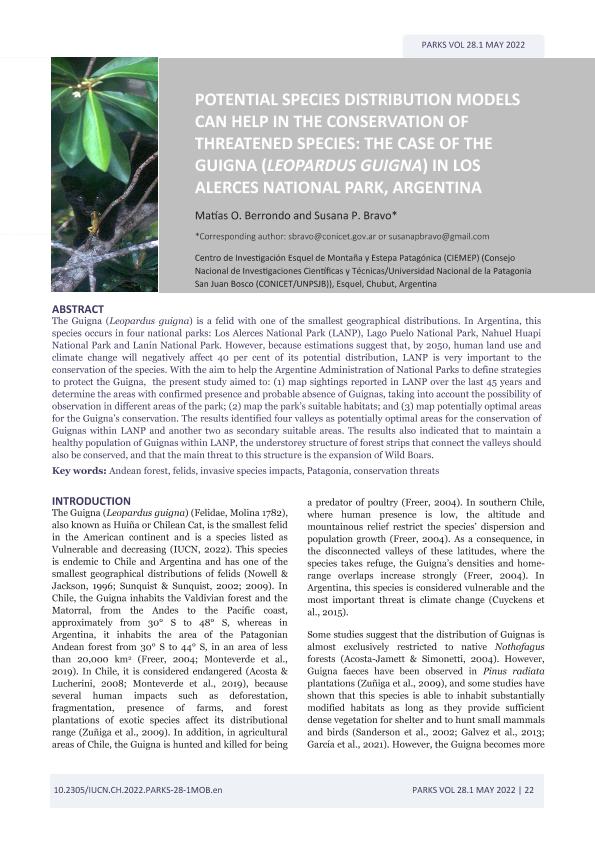Mostrar el registro sencillo del ítem
dc.contributor.author
Berrondo, Matías Omar

dc.contributor.author
Bravo, Susana Patricia

dc.date.available
2022-07-27T19:18:07Z
dc.date.issued
2022-05
dc.identifier.citation
Berrondo, Matías Omar; Bravo, Susana Patricia; Potential species distribution models can help in the conservation of threatened species: The case of the Guigna (Leopardus guigna) in Los Alerces National Park, Argentina; International Union for the Conservation of Nature; Parks; 28; 1; 5-2022; 22-30
dc.identifier.issn
0960-233X
dc.identifier.uri
http://hdl.handle.net/11336/163322
dc.description.abstract
The Guigna (Leopardus guigna) is a felid with one of the smallest geographical distributions. In Argentina, this species occurs in four national parks: Los Alerces National Park (LANP), Lago Puelo National Park, Nahuel Huapi National Park and Lanín National Park. However, because estimations suggest that, by 2050, human land use and climate change will negatively affect 40 per cent of its potential distribution, LANP is very important to the conservation of the species. With the aim to help the Argentine Administration of National Parks to define strategies to protect the Guigna, the present study aimed to: (1) map sightings reported in LANP over the last 45 years and determine the areas with confirmed presence and probable absence of Guignas, taking into account the possibility of observation in different areas of the park; (2) map the park´s suitable habitats; and (3) map potentially optimal areas for the Guigna´s conservation. The results identified four valleys as potentially optimal areas for the conservation of Guignas within LANP and another two as secondary suitable areas. The results also indicated that to maintain a healthy population of Guignas within LANP, the understorey structure of forest strips that connect the valleys should also be conserved, and that the main threat to this structure is the expansion of Wild Boars.
dc.format
application/pdf
dc.language.iso
eng
dc.publisher
International Union for the Conservation of Nature
dc.rights
info:eu-repo/semantics/openAccess
dc.rights.uri
https://creativecommons.org/licenses/by-nc-sa/2.5/ar/
dc.subject
Andean forest
dc.subject
Felids
dc.subject
Invasive species impacts
dc.subject
Patagonia
dc.subject.classification
Conservación de la Biodiversidad

dc.subject.classification
Ciencias Biológicas

dc.subject.classification
CIENCIAS NATURALES Y EXACTAS

dc.title
Potential species distribution models can help in the conservation of threatened species: The case of the Guigna (Leopardus guigna) in Los Alerces National Park, Argentina
dc.type
info:eu-repo/semantics/article
dc.type
info:ar-repo/semantics/artículo
dc.type
info:eu-repo/semantics/publishedVersion
dc.date.updated
2022-07-04T19:56:34Z
dc.identifier.eissn
2411-2119
dc.journal.volume
28
dc.journal.number
1
dc.journal.pagination
22-30
dc.journal.pais
Suiza

dc.journal.ciudad
Gland
dc.description.fil
Fil: Berrondo, Matías Omar. Consejo Nacional de Investigaciones Científicas y Técnicas. Centro Científico Tecnológico Conicet - Patagonia Norte. Centro de Investigación Esquel de Montaña y Estepa Patagónica. Universidad Nacional de la Patagonia "San Juan Bosco". Centro de Investigación Esquel de Montaña y Estepa Patagónica; Argentina
dc.description.fil
Fil: Bravo, Susana Patricia. Consejo Nacional de Investigaciones Científicas y Técnicas. Centro Científico Tecnológico Conicet - Patagonia Norte. Centro de Investigación Esquel de Montaña y Estepa Patagónica. Universidad Nacional de la Patagonia "San Juan Bosco". Centro de Investigación Esquel de Montaña y Estepa Patagónica; Argentina
dc.journal.title
Parks
dc.relation.alternativeid
info:eu-repo/semantics/altIdentifier/url/https://parksjournal.com/parks-28-1-may-2022/
Archivos asociados
